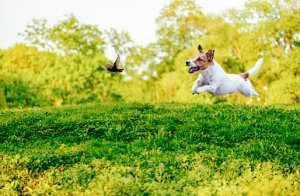Spring is here! After months of spending too much time cooped up inside, avoiding the dangers of winter weather, you—and your dog—can finally get back outdoors and resume your more active lifestyle.
But don’t run for the front door just yet. Spring may not come with snow, ice, and below-freezing temperatures, but it does present its own risks and dangers… especially for our four-legged friends. And if you want to keep your dog safe and in good health, you’ll have to keep your eyes peeled for them and take other measures to limit your dog’s exposure.
Spring Toxins Can Be Very Harmful, Even Fatal, to Pets
 Here are some of the things that you should watch out for when enjoying the spring weather with your canine companion:
Here are some of the things that you should watch out for when enjoying the spring weather with your canine companion:
- Chemical Spills. Many of the chemicals used in automobiles can harm your pet if ingested, and some, such as antifreeze, can be fatal. During the winter months, as people make sure their vehicles are safe and road-ready, these chemicals are used—and spilled—more often, resulting in chemical spills that can, and do, last well into the spring.
- Rodenticides.When spring hits, people (and dogs) aren’t the only creatures that want to get out and start living again. Many other animals, including rodents, are eager to too—and many homeowners and businessowners are eager to prevent them. The anticoagulants found in rodenticides used in rodent baits and traps can cause stomach bleeding if your dog even comes into contact with them.
- Snail and Slug Baits. The key ingredient in snail and slug bait is Metaldehyde, which is fatal to dogs and responsible for numerous pet deaths each spring.
- Lawn Chemicals. Nothing says spring like a beautifully maintained yard or flowerbed! But if your dog ingests, or is otherwise exposed to, certain lawn chemicals, it could spell out serious trouble. Many lawn fertilizers contain chemicals that can cause toxicity in dogs, and some products, such as fertilizers commonly used around roses, can be fatal even in very small doses.
- Household Cleaners. With spring, comes spring cleaning… and your responsibility to make sure that your dog keeps its nose (and tongue) away from your cleaning products. Many popular household cleaners contain active ingredients that can cause myriad problems, from oral ulcers to kidney failure, and any surface cleaned with them should be allowed to completely dry before your dog gets near it.
- Compost Bins. When properly set up and maintained, compost bins are a great thing. But when done improperly, they can give your dog access to heaps of molding, decaying food that may contain harmful mycotoxins.
- Mushrooms. Mushrooms contain ten different toxins that have been shown to harm dogs in numerous different ways, and to different extents, depending on their individual susceptibility.
- Plants. Many plants are toxic to dogs and other domestic animals. Others are not toxic but may have been treated with chemicals that are. What’s more some plants that are considered “safe” for most animals, may prove problematic for your dog for any variety of reasons.
Protect Your Dog Through Diligence and Planning
Paying close attention to your dog in outdoor environments, avoiding unfamiliar or risk-ridden areas, and being more mindful of your own cleaning and maintenance habits can help you accomplish a lot in terms of limiting your dog’s exposure to spring toxins. For additional resources and tips, we encourage you to bring your dog in for a “spring checkup.” The staff and veterinarians at Animal Medical Center of Streetsboro are here to serve you throughout the seasons.
Call today to schedule your dog’s appointment.
**If your dog has ingested, or been exposed to, any of the toxins listed above, please seek medical attention immediately. **

